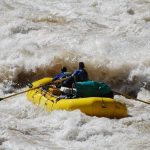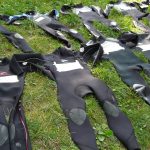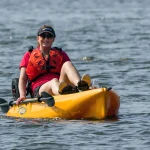Although it may be scary to start kayaking, it is still a great activity to do. There is a lot you need to learn, but it will be worth it in the end.
The challenge makes it more fun because it is more difficult.
Before you go kayaking, there are some safety tips you should be aware of.
Although it may be difficult to become an expert, kayaking is a simple sport to learn.
The most important thing for first-time kayakers to do is to focus on learning the basics of the sport.
The most important thing you can do to make sure your time on the water goes well is to learn how to swim. This is the foundation for all other activities you’ll do in the water, so it’s crucial that you know how to swim.
Tips First-Time Paddlers Should Know
I’ve only discussed the basics so far, essential skills you need to be able to do before you even think about taking your kayak out. But there’s still a lot more to cover.
There are things you should know and be aware of as you get into kayaking.
Learn How To Get In & Out Of A Kayak
You will not be able to leave until you have learned how to enter and exit a kayak.
Aren’t we supposed to get it easily?
Although it may seem like it would be easy to transition from solid ground to water, it doesn’t always go as planned.
I didn’t succeed immediately – and while I’m not saying you can’t either, it’s probably better to educate yourself on how to do it correctly, just to be safe. It just takes some practice; you’ll figure it out and get over the initial instability quickly.
The three methods of launching a kayak you should work on are:
- Getting into a kayak from the shore
- Getting into a kayak from a dock
- Getting into a kayak from the water
If you don’t pay attention to this part of launching your kayak, you could accidentally end up in the water.
As for getting out of a kayak, the instructions couldn’t be more straightforward:
Just complete the steps in reverse.
Learn Proper Kayak Paddling Technique
Paddling a kayak is not difficult, but it does take some time to learn the basics.
Before you set out on your first outing, make sure that you know:
- How to hold a kayak paddle, orient it correctly, and maintain the so-called paddler’s box
- How to perform basic paddle strokes, focusing on the forward, reverse, sweep, and draw strokes
- How to perform basic turns and maneuver your kayak
As a beginner, it is important to learn proper paddling techniques from either a class or an experienced paddler. This will help reduce fatigue, prevent injuries, and allow you to control your kayak more efficiently. Plus, it will make your outings more enjoyable overall.
A tip to spot someone who is new to paddling is that they will have their paddle blades around the wrong way. This will make them much less effective and look foolish.
Typically, the brand’s sticker will be located on the front of the paddle blade. If you are looking at the blade face, the sticker should be easily readable if the blade is positioned correctly.
How To Sit In A Kayak
Before you start paddling, you need to adjust the footrests in your kayak so you can sit upright. There are several ways that footrests adjust, so you will need to find out how yours work.
Some have a trigger behind the foot brace pedal that you squeeze to move the pedal, while others have a long stick that you lift or twist to free the pedal so it can be moved. Take a moment to get comfortable with how your footrests are adjusted before you start paddling.
After you have learned how to adjust the foot braces, you can begin to set up your kayak for comfort and efficiency. To do this, adjust the pedals so that your knees are bent and your foot is in a neutral position.
Imagine that your foot and ankle are forming the letter “L” when you press on the pedal. If you need to point your toes, the pedals are too far away.
Your legs should be positioned in a way that when you press on the footrests, your thighs are touching the thigh braces (if your kayak has them).
If your kayak has a large open cockpit, you can rest the outside of your thighs against the inside edge of the cockpit opening. Your knees should be bent enough that when you press on your feet, you can sit upright in the seat without slouching back.
How To Steer A Kayak
Kayakers use different strokes to steer their kayaks depending on the direction they want to go. A forward stroke is used when paddling forward, and a reverse stroke is used when going backward.
You can also alternate between a forward stroke on one side and a reverse stroke on the other side to turn around in a circle while remaining stationary.
Forward Turns
Complete the stroke on the other side of the boat. Use a stroke that sweeps the paddle forward to turn your kayak when moving forward. This stroke is similar to the regular forward paddling stroke, but more exaggerated.
Put the paddle in the water close to the bow of the boat, with the power face pointing away from the hull. Pull the blade through the water in a wide arc, following it with your eyes.
When the blade nears the stern, lower your top hand to pull the blade free of the water.
Complete the stroke on the other side of the boat.
Keep the paddle shaft low during the stroke.
This stroke will turn the kayak the most if you are moving forward.
This stroke will have a big turning effect if you are standing still in the middle of it.
Reverse Turns
To do a reverse sweep, twist your body so you can reach the paddle near the back of the kayak. The power face of the paddle should be facing the hull.
Use the back face of the paddle for the stroke, sweeping the blade in a wide arc away from the kayak. Keep your eyes on the blade until it’s close to the front of the kayak, then slice it out of the water.
The paddle shaft is held low during the stroke.
If you are moving forward and you do a reverse sweep, it will turn the boat sharply, but it will also slow your boat down a lot.
How to Roll a Kayak
If you learn how to do a kayak roll, you will be much less likely to need to swim out of your kayak if you flip over in turbulent water. This technique is useful for whitewater kayakers, surf kayakers, or sea kayakers who paddle in challenging conditions.
Not only that, but once you know how to roll, it will be easier for you to learn other advanced skills that will help you stay upright.
You’re on your way. The maneuver is simple. The paddle is swept outward from the kayak while upside down, lifting the body of the paddler toward the surface.
The paddler then uses pressure on their knees to flip the kayak upright and bring themselves back into balance.
The roll may sound easy, but it can actually be quite challenging to learn. It’s a complex skill that requires muscle memory to execute. Many motions need to be done in quick succession without thinking about them.
This means most people have to methodically drill the different segments of the roll before they can begin to tie them together into a complete technique.
Although it is best to learn the skill of kayaking from a skilled instructor in a controlled environment, such as a swimming pool, don’t be discouraged from investing time and effort into learning this important technique.
How to Get Back on a Capsized Kayak
If your kayak tips over, it depends on the type of kayak and how much you have practiced self-rescue skills.
If a recreational kayak flips over, the kayaker will need to swim it to shore and empty it of water. This type of kayak does not have enough buoyancy to float high in the water if swamped, so it is best to only paddle them close to shore.
You can flip a sit-on-top kayak back over in deep water without it filling with water, allowing the paddler to just climb back on top of the kayak from the water.
This makes sit-on-tops a good choice for recreational kayaking if you want to be able to paddle further away from the shore.
Touring kayaks have watertight compartments that increase floatation. This means they can be re-entered in deep water and paddled to safety. Several rescue techniques will help a kayaker get back into her boat in the event of a flip.
The rescues done with a partner are the fastest and end up with the least amount of water left in the boat. Solo rescues are more time-consuming and require the cockpit to be pumped out once the paddler is back in the kayak. In cold water, this is a big disadvantage.
The two most common types of rescue are the T or X rescue (when a kayak gets swamped and is emptied over the deck of a companion’s boat) and the paddle float self-rescue (when a float is attached to one end of the paddle and the other end is secured to the deck of the kayak, creating an outrigger).
Rescues are serious safety skills that should be practiced until you can them quickly and skillfully. If you’re new to kayaking, you shouldn’t venture far from shore until you’ve had a chance to develop these skills.
Learn River Hand Signals
You might be surprised at how much noise flowing water can make, making it difficult to communicate. As you spend more time on the water, you’ll learn how important it is to be able to stay in contact with everyone in your group.
But yelling all day isn’t fun, is it?
Despite the fact that kayakers can’t speak to each other while they’re on the water, there are still ways for them to communicate. By learning a series of hand signals, kayakers can still stay in contact with one another while they’re paddling.
If you’re planning on kayaking with a group, it’s a good idea to learn these signals.
You never know when these can come in handy.
Learn How To Perform A Self-Rescue
One of the essential kayaking lessons you should master as a beginner is safety-related. This should not surprise you as spending time on the water carries some inherent risks.
Even if you don’t flip over immediately when you first hit the water, you should still be prepared for it.
That’s why I recommend that you practice basic self-rescue drills – preferably in a controlled environment and with a paddling instructor – focusing on the following:
- Learning how to roll your kayak to recover from capsizing without getting out of the ‘yak
- Learning how to perform a wet exit to get out of a flipped ‘yak safely
- Learning how to re-enter the kayak by performing a kayak T-rescue, paddle float rescue, or the scramble self-rescue
Consider this a part of personal preparedness and responsibility.
Kayaks Can Be Replaced – People Can’t
I understand that you have invested a lot of money in your kayak, but if things go wrong, don’t prioritize the boat over your safety.
In difficult situations, it is easy to forget what is most important.
So, let’s just get one thing straight:
The best thing to do if you see a kayaker or canoeist in trouble is to go to them and offer help. Only try to rescue their equipment if you can do so without putting yourself in danger.
The life of a human is more important than a kayak.
Although it is understandable to be upset over the loss of new gear, it is never more important than the safety of other paddlers.
Summary
Here are the key kayaking tips to remember for a smooth experience:
1. Get to know your kayak before getting in the water.
2. Start slow and gradually increase your speed.
3. Don’t forget to paddle on both sides.
4. Use your body to steer, not just your arms.
5. Practice in calm waters before venturing out into the open water.
Start by building a foundation of paddling knowledge, then have fun while staying safe!



